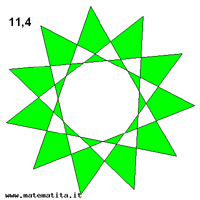This is the text of the poster you can see here.
When 2+2 is equal to 1
In common language, all things related to numbers are often used as models of unarguable certainty. After all, numbers are used to counting and by counting you should know that, for instance, 4 is different from 7 and 2+2, which is equal to 4, is different from 7… but it depends!
In everyday life, there are various situations in which it happens to “count” in a different way from what is usually done; however, nobody is less serene. Perhaps somebody would be less serene if he knew it is all about Math, in particular about Modular Arithmetic… but this is a well-kept secret.
Three kids (Annie, Joe and Charlie) are counting out to decide who is going to play first: they are reciting the rhyme “A-u-lì-u-lè-ka-tà-mu-sé-…”. In order, they are pointing one of them for each syllable they are saying until the rhyme ends and the last syllable… chooses the first to play. Assume none of them is cheating, which it may be if syllables overlap or if they swallow their words. We just need to know how many syllables there are in the rhyme so that we could guess which of the three kids is going to play first. This is a rhyme made up of 27 syllables. If Annie starts to recite it and they go on in alphabetical order, the last syllable chooses Charlie.
This is a very strange arithmetic. In fact, a rhyme with 27 syllables has the same effect as that with 3 syllables (or with 6, 9 or 99): it is an arithmetic for which 27 is equal to 3, 6, 9…
If the rhyme had 28 syllables, we would find out that 28 is equal to 25 and 22…, to 13 and 7 and 4 and even to 1. Thus, 2+2 is equal to 4, but also to 1 (or, if you prefer, to 25 or 28).
It is as if all multiples of 3 were equal to zero and we kept track of the remainder when we divide a number by 3. There are the numbers which are multiples of 3 (which correspond to Charlie), those with remainder one when divided by 3 (Annie) and those with remainder 2 when divided by 3 (Joe).
We do not need to go back to our childhood to discover such an arithmetic. Just think of the arithmetic of a clock, where the role of the number 3 in the previous example is taken by the number 12: we thus refer to an arithmetic modulo 12. We can also talk about the arithmetic of the the days of the week (modulo 7) or, more simply, that of the odd and the even numbers (modulo 2). They are different ways of counting in situations when something repeats periodically.
In general, very simple concepts are very deep too. We should not be too much surprised if, since childhood, we are familiar with modular arithmetic (even if we are not aware of it) which, at the same time, is the foundation of current theoretical research in Number Theory. It is also the foundation of some of the most recent applications, which progress in Cryptography has introduced in everyday life, from ATM cards to the e-commerce.



